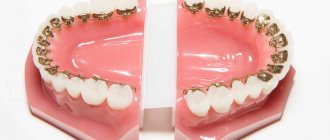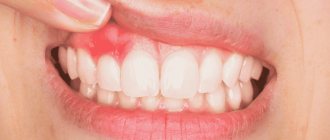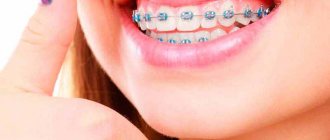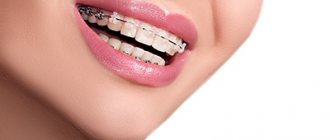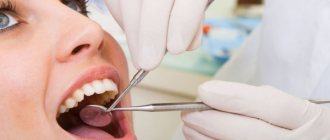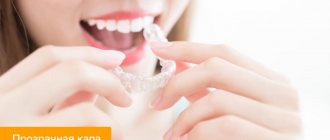Consequences of installing braces
The benefits of braces are undeniable. These orthodontic products are actively used to correct various dental defects. However, if used incorrectly, braces can cause harm. Before installing them, the doctor will definitely tell the patient about possible negative consequences (which are often temporary). These include:
- Unpleasant feeling in the mouth . This is a normal reaction to the appearance of a foreign object in the oral cavity. As a rule, it takes 2-4 weeks to get used to braces. The first days are the most unpleasant, but very soon you will feel relief and then you will get used to it.
- Toothache . The main task of braces is to move and/or rotate the tooth into an anatomically correct position. Accordingly, as the tooth dislocates, the soft tissues are slightly injured. Pain occurs. In most cases, it is mild and aching in nature. In rare cases, the patient has to take painkillers.
- Increased salivation . This symptom will also have to be endured, since it is temporary. The appearance of a foreign body in the oral cavity is a signal for increased salivation. After a few days, saliva production returns to normal.
- Impaired diction . Those who are forced to work for the public suffer the most. On the other hand, such people especially need to take care of the beauty of their teeth. So we have to make such “sacrifices”. Note that this problem is also temporary. You adapt to new conditions very quickly.
- Problems with gums . Some patients may initially experience minor inflammation on their gums caused by braces. This is easy to deal with. It is enough to rinse your mouth with special solutions and use anti-inflammatory gels. But if the inflammation is caused by insufficient hygiene when wearing braces, then the treatment will be more complex and lengthy. Sometimes in such cases the doctor removes the braces ahead of schedule.
- Psychological consequences of braces . Many people develop complexes. They feel embarrassed to smile. They cover their smile with their hand or simply try not to open their mouth. From the outside it looks strange and not aesthetically pleasing. Today, you won’t surprise anyone with braces, so you shouldn’t be ashamed of them.
- Caries after braces . Be carefull! The most important and difficult task after installing braces is to keep your teeth and mouth clean. This should be done after every meal. If you neglect this rule, then caries appears very quickly.
- Damage to teeth . This is a rare complication that occurs due to improper stress on the teeth. As a rule, such problems can arise when the crown part of the teeth is shortened.
Also, other side effects (usually temporary) are possible from braces, depending on individual characteristics. The doctor will tell the patient about this.
At what age is it better to get braces?
In adolescents aged 13-18 years, the dentition is most susceptible to various changes, so this time is optimal. The treatment will be much faster and painless. However, the structures can also be installed in patients of other age categories.
Malocclusion in children becomes noticeable even when the milk lines appear. Parents should take the child to a pediatric orthodontist so that the doctor can decide whether to install a corrective device. However, before the 12th birthday, there is a high probability of damage to the enamel layer. In addition, pathological changes in insufficiently formed roots are possible, which threatens the loss of incisors, canines and molars. Criteria by which children’s readiness for therapy is determined:
- sufficient enamel strength;
- suitable length of the coronal part;
- presence of anterior molar units.
Some people mistakenly believe that braces are useless for adults. Doctors note that the system can be used until the rows are completely healthy. However, there are some nuances here. The jaws are formed and are no longer so pliable, so the treatment will take a long time. In some cases, removal is required. In adulthood, various problems appear (caries, gum inflammation, thinning of hard tissues), which must be eliminated before the intervention of an orthodontist.
Consequences after removing braces
Consequences of braces are possible even after they are removed. Possible problems include:
- Stains on enamel . This effect is possible due to poor hygiene. Teeth whitening and remineralization will help correct the situation.
- Changing the shape of the face . This is a very rare occurrence. And if the patient experiences drooping of the cheeks or changes in the nasolabial folds, then the defects are quickly restored with the help of special gymnastics.
- Demineralization of enamel . Another potential disadvantage of braces is the weakening of the enamel. This is due to the fact that under the structure the hard tissues of the tooth did not receive enough of the necessary microelements. To minimize the risk of such a complication, courses of treatment to strengthen the enamel (remineralization) are prescribed after braces.
- The teeth returned to their previous position . To prevent teeth from moving apart after braces, the patient needs to wear retainers for some time. These are special orthodontic splints that are placed on the teeth to secure the result.
Dental braces: what are they?
The design consists of brackets made of metal, ceramics or other materials. The system is attached to the outside or inside of the jaws. All elements are held on a special thin wire.
An orthodontic apparatus is necessary to eliminate pathologies that are associated with incorrect position of teeth. People mistakenly believe that the main purpose of such intervention is the aesthetic appeal of a smile. Doctors do not agree with this and argue that the curvature of incisors, canines and molars is primarily a medical problem, since it often leads to health problems. Food is not crushed enough when chewed, and then poorly digested, as a result of which diseases of the gastrointestinal tract develop.
There are other pathological processes that can only be dealt with with the help of staples. In some cases, extraction is required before installation.
Causes of problems
Negative consequences of braces most often occur when medical recommendations are not followed, namely:
- poor oral hygiene;
- consumption of foods that are undesirable during treatment with braces;
- non-compliance with other medical recommendations (they are individual for each patient).
Problems when wearing braces can also arise due to weakened immunity and some individual characteristics of the body. It is important to consult a doctor in a timely manner to eliminate current disorders. Before installing the structure, the doctor weighs all the pros and cons of such treatment, taking into account the patient’s characteristics.
Biomechanics of tooth movement
To understand how braces work, let’s look at the biological and physiological processes that occur during tooth movement. The teeth are located in the alveoli - natural depressions in the jaw bones of the skull. The root of each tooth is surrounded by periodontal fibers that hold the tooth in the socket. The fibers also perform a shock-absorbing function: they allow the tooth to make micro-movements in all directions. After fixing the bracket and installing the arch, force begins to act on the root of the tooth. To move teeth slowly and less painfully, a weak and prolonged force is applied.
Due to the movement of the tooth root, there is a need to free up space in the alveolus. To do this, osteoclasts begin to destroy the bone where the root touches the alveolar wall. Osteoclasts are special cells that remove bone tissue. On the opposite side, osteoblasts produce new bone to fill the vacated space. Under the influence of osteoclasts and osteoblasts, the balance of formation and destruction of bone tissue ensures the progressive movement of teeth.
Myths about the negative consequences of braces
We talk about the most common misconceptions regarding complications when wearing braces.
Braces lead to tooth decay
Braces do increase the risk of caries, but only if hygiene rules are neglected. To prevent caries from forming under braces, the products are fixed using orthodontic glue, which also has protective properties against the enamel.
After installing braces, the doctor will tell the patient how to brush their teeth properly. To do this, you will need dental floss, special brushes, and an irrigator. This cleaning will remove any food particles that may be stuck between the elements of the orthodontic structure.
Braces change the color of the enamel
After braces are removed, the areas of the teeth where the glue was applied may differ in color. But this is a temporary phenomenon. The patient undergoes professional cleaning and resurfacing. The natural color of teeth is restored and evened out within 2-3 weeks.
Braces cause crooked teeth
Everything is exactly the opposite. Braces straighten the teeth, particularly in cases of abnormal bite. And this is the main purpose and benefit of these structures. Problems arise when the patient refuses retainers. These are temporary orthodontic splints that are placed to prevent teeth from moving apart again.
Interdental gaps appear after braces
A gap between teeth after braces may appear for a short time until retainers are installed. After installing the splints, the teeth are in the correct position and the gap disappears.
Braces damage your gums
Gum problems after braces occur in approximately 4% of patients. Most often, the reason for this is insufficient hygiene or uneven chewing load (which was incorrectly calculated when installing the structure).
Braces cause headaches
Sometimes I get headaches after getting braces. This is a relatively rare side effect that is temporary. This problem can be solved after getting used to the design.
Pros and cons of ligature braces
Advantages:
- correction of anomalies of the dental system of increased complexity: ligatures give the system additional strength and reliability;
- the ability to change the types of ligatures according to the patient’s choice; colored ones are especially suitable for children, white and colorless – for adults; rubber ligatures can be replaced with wire ones;
- the possibility of frequent monitoring of the treatment process with changes in specified parameters;
- reasonable price and wide selection of prices.
Flaws:
- lengthy process of installing ligature braces;
- the system is bulky and noticeable on the teeth;
- transparent and colorless ligatures quickly turn yellow from food coloring and take on an unaesthetic appearance;
- the need for monthly visits to the orthodontist to monitor and correct treatment;
- frequent complaints from patients about irritation of the oral mucosa with ligatures, which helps to lengthen the period of adaptation to the system; after changing the ligatures, the patient may feel pain for some time;
- it is more difficult to carry out hygiene procedures.
Features of proper care
To prevent teeth from deteriorating after braces, it is important to follow basic oral care rules. These are 3 key recommendations:
- Proper hygiene . If you have braces, then from now on you won’t be able to get by with just a toothbrush. In addition, special brushes, small brushes, dental floss and mouthwash are also used. It is also advisable to use an irrigator to wash the oral cavity. Such hygiene is necessary to prevent caries, so that teeth do not deteriorate.
- Power control . Braces are a fairly fragile structure that can be damaged by hard foods, such as nuts, crackers, hard cheese and others. Avoid such foods, as well as sticky foods. If a breakdown or deformation of structural elements suddenly occurs, you should consult a doctor as soon as possible. It is contraindicated to remove braces on your own.
- Examinations with a doctor . In addition to the emergency cases described above, you also need to regularly go to the doctor for preventive examinations. Most often this is once a month, but an individual schedule is drawn up for each patient.
How to avoid unpleasant consequences?
Preventing the consequences of wearing braces includes actions such as:
- Careful daily oral hygiene.
During daily procedures, it is important to use not only a brush and toothpaste, but also dental floss, an irrigator, and orthodontic brushes. When brushing your teeth, do not put excessive pressure on the enamel and gums. - Elimination of self-removal of the structure.
Only a dentist should remove the braces system; under no circumstances should you try to dismantle it yourself, even if there is a good reason for doing so. - Timely contact with the orthodontist.
If the structure becomes loose or broken, it is important to contact a specialist as soon as possible. The orthodontist will examine your mouth and, if necessary, your braces.
We hope your orthodontic treatment will be successful, and after the braces are removed, you will be the happy owner of a beautiful smile. Take care of your teeth and remember, ASEPTA products will always help you cope with any dental problem.
Sources:
- The effectiveness of the use of Asept “adhesive balm” and Asept “gel with propolis” in the treatment of chronic generalized periodontitis and gingivitis in the acute stage (Municipal Dental Clinic No. 4, Bryansk, Kaminskaya T. M. Head of the therapeutic department Kaminskaya Tatyana Mikhailovna MUZ City Dental Clinic No. 4, Bryansk
- Report on clinical trials to determine/confirm the preventive properties of commercially produced personal oral hygiene products: mouth rinse "ASEPTA PARODONTAL" - Solution for irrigator." Doctor of Medical Sciences Professor, Honored Doctor of the Russian Federation, Head. Department of Preventive Dentistry S.B. Ulitovsky, doctor-researcher A.A. Leontiev First St. Petersburg State Medical University named after academician I.P. Pavlova, Department of Preventive Dentistry.
- Clinical studies of antisensitive toothpaste “Asepta Sensitive” (A.A. Leontyev, O.V. Kalinina, S.B. Ulitovsky) A.A. LEONTIEV, dentist O.V. KALININA, dentist S.B. ULITOVSKY, Doctor of Medical Sciences, Prof. Department of Therapeutic Dentistry, St. Petersburg State Medical University named after. acad. I.P. Pavlova
- Report on the determination/confirmation of the preventive properties of personal oral hygiene products “ASEPTA PLUS” Remineralization doctor-researcher A.A. Leontyev, head Department of Preventive Dentistry, Doctor of Medical Sciences, Professor S.B. Ulitovsky First St. Petersburg State Medical University named after. acad. I.P. Pavlova, Department of Preventive Dentistry
Restoring enamel after braces
The aesthetic consequences of braces can be successfully eliminated using the following procedures:
- professional cleaning;
- teeth whitening;
- installation of retainers with a special composition that strengthens the enamel;
- polishing and processing of enamel with special solutions.
FAQ
How does the oval of the face change after braces?
The face after braces becomes more symmetrical and proportional. This is a consequence of correcting the bite. For example, if a patient’s teeth do not close together and the face appears elongated, then after correction with braces the cosmetic defect is eliminated. Most often, after such treatment, the cheekbones become more expressive and the cheeks become sunken.
Is it possible not to wear retainers after braces?
Can. However, the consequences of such a decision are difficult to predict. The teeth will again try to return to their previous position. And then, 1-2 years of correction with braces will be useless.
Do braces make your lips look bigger?
Visually, yes, because there is a bracket arch under the lip. However, after removing the structure, the effect of lip augmentation disappears.
Do teeth fall out from braces?
No, they don't fall out. And information about this is just rumors that have no basis.
How much do ligature braces cost?
If we compare the cost of treatment, it depends on:
- diagnostic studies performed;
- the need and scope of oral sanitation;
- chosen design – material of manufacture, manufacturer;
- the orthodontist’s work on installation, activation and removal of the structure.
For comparison: the cost of installing the domestic metal model Pilot on one jaw is from 9 thousand rubles, and the metal model Alexander (USA) is from 14 thousand rubles. Ceramic models are more expensive - Clarity (USA) - from 40 thousand rubles, sapphire Inspire Ice - from 35 thousand rubles. Bracket systems made of high-quality plastic are also not cheap: installation by Spirit (USA) will cost from 26 thousand rubles.
